
LA ISLA DEL ENCANTO
An exploration of history, culture
and Puerto Rican life.
By JAMES MCINTOSH

Hurricane Maria as it crosses Puerto Rico in September 2017.
As the plane descended, we gazed out the window, peeking between the scattered clouds trying to get a glimpse of the island below. In the weeks leading up to our arrival in Puerto Rico, people had kept asking, “Have they recovered from the Hurricane? Is everything open?”
It was more than 18 months since Hurricane Maria made landfall just south of Yabucoa harbor on Sept. 20, 2017. When Maria reached Puerto Rico the National Weather Service recorded sustained winds of 155 miles per hour, nearly a Category 5 storm, and the most powerful hurricane to hit the island since 1932.
With such short news cycles, and the storm a distant memory for those of us living on the mainland, we were intrigued to see how the recovery was progressing and if we would have the opportunity to see Puerto Rico at its best.
From the window of the plane it was hard to tell. Between the clouds we could see flashes of lush, green jungle flowing down to stretching white-sand beaches. And as we moved closer to San Juan, the appearance of scattered buildings and soon an expansive, bustling city that from 5,000 feet seemed to have put the horrors of Hurricane Maria behind it.
// As the wheels touched the runway, we felt the rush of excitement only ignited from the anticipation of exploring a new and mysterious place.

// OLD
SAN JUAN
One of the most captivating aspects of Puerto Rico is the collision of old and new that permeates the island. Around every corner of San Juan there are constant reminders of a new and energetic age pulsing through the infrastructure and architecture of an Old World.
This intriguing contrast is no clearer anywhere in Puerto Rico than in the blue-toned cobblestone streets and kaleidoscope colored walls of Old San Juan. While planning the trip, we knew we wanted to spend a majority of our time in San Juan in Old Town, so we looked for accommodation that was both affordable and centrally located.
We ultimately found Casa Los Cummins, which served as a perfect home base during our stay in the capital city. The boutique hotel is nestled on a quiet road in the seaside neighborhood of Condado, only two blocks from the beach and three miles from Old San Juan.
It’s only a short taxi ride from San Juan Luis Muñoz Marín International Airport into the city. Ubers aren’t currently allowed to pick up passengers at the airport, so it’s best to pay for a fixed fare taxi to get safely and conveniently to your hotel.

Casa Los Cummins in the Condado neighborhood of San Juan, Puerto Rico.

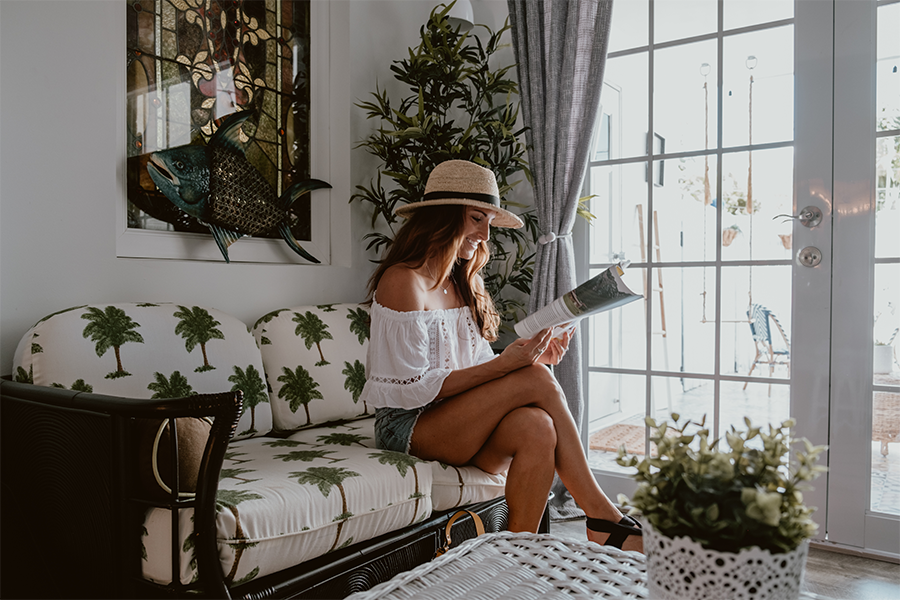
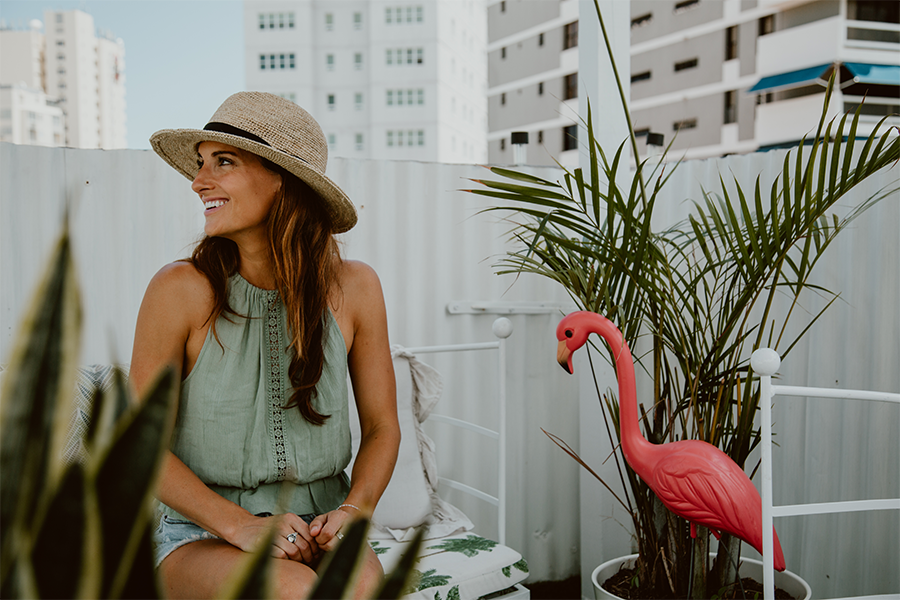
// We experienced our first taste of warmhearted Puerto Rican hospitality upon our arrival at Casa Los Cummins.
The smiling faces of the welcoming hotel staff were just what we need to see after a redeye flight from the west coast. They even let us into our room well before the designated check-in time, which allowed time to unpack and take a shower before rushing out the door to uncover the rich history, vibrant culture and captivating rhythm of San Juan.

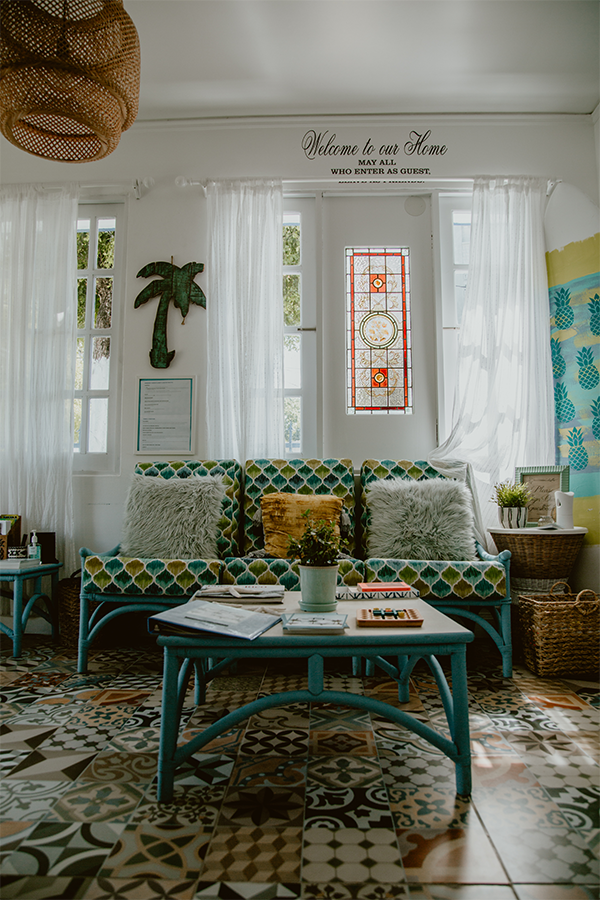
Casa Los Cummins, Condado.

Old Town San Juan, Puerto Rico.
While San Juan is much bigger than just the Old Town district, the ancient part of the city is where we focused our time. Located on a small and narrow island and connected to the rest of the city by three bridges, Old San Juan is comprised of four distinct areas.
The north of the island is primarily comprised of the residential part of the city. The south is the port area, which serves as the tourist and commercial hub where many of the shops and restaurants are located. The eastern side of the city is protected by Fort San Cristobal, while the west features Paseo de la Princesa, the governor’s mansion and the world-famous Fort El Morro – with ramparts that tower 144 feet above the sea, guarding the port.
There are many ways to initially explore Old San Juan including guided tours, but we chose to simply take an Uber from our hotel in Condado straight to Fort El Morro at the far western end.
Construction on El Morro began in 1539 and didn’t end for more than 250 years. In that timeframe El Morro grew from a single cannon on a hill to a six-level fortress, glaring out across the Atlantic, deterring and defending Puerto Rico from invasions by the British, Dutch and pirates.
Today, El Morro is a U.S. National Historic and UNESCO World Heritage Site open seven days a week from 9 a.m. to 6 p.m. The entrance fee is $7 for adults and the impressive site marks the perfect starting point for a self-guided walking tour of Old San Juan.


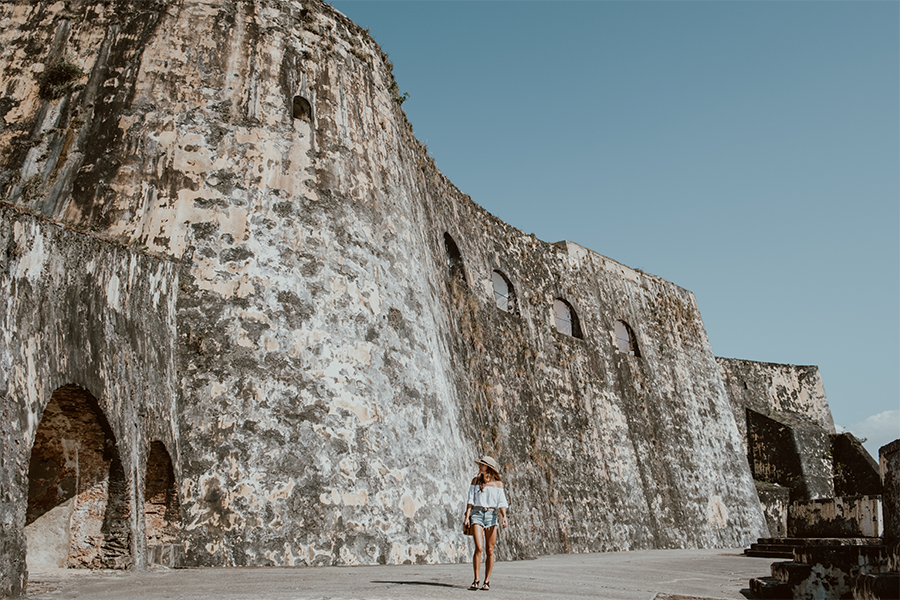
El Morro in San Juan, Puerto Rico.
From the entrance of El Morro, the remainder of the ancient city is easily accessible. It’s a short walk through beautiful cobblestone streets to see some of the top attractions including La Fortaleza (the governor’s mansion), Paseo de la Princesa, the Cathedral of San Juan Bautista and Fortaleza Street, a narrow road covered by a blanket of colorful umbrellas.
While roaming the streets of Old San Juan from point to point, it’s important to take time to duck into the small shops and hole-in-the-wall bars for a souvenir and a refreshing Medalla Light.
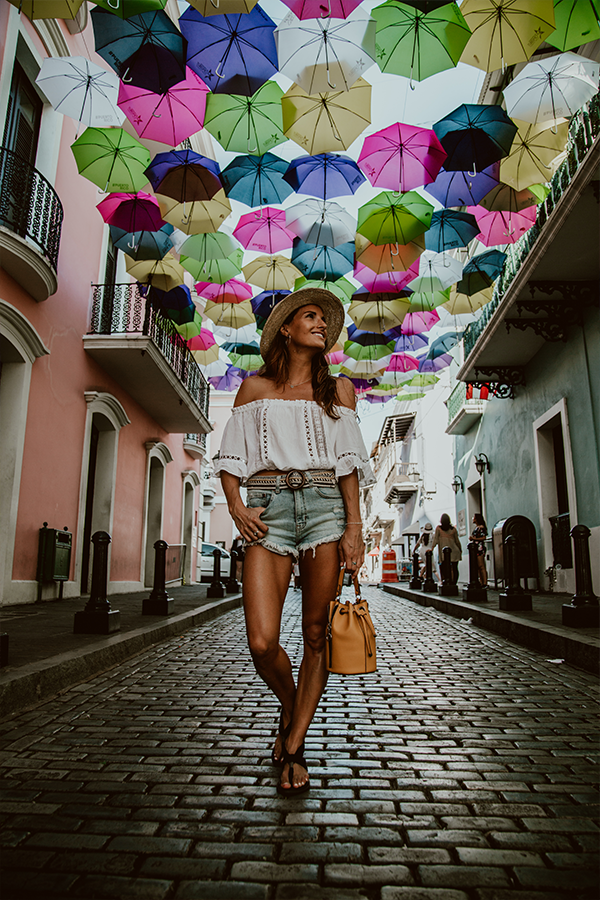



// It’s also important to slow down and fully absorb the slowly changing mood swings of the day.
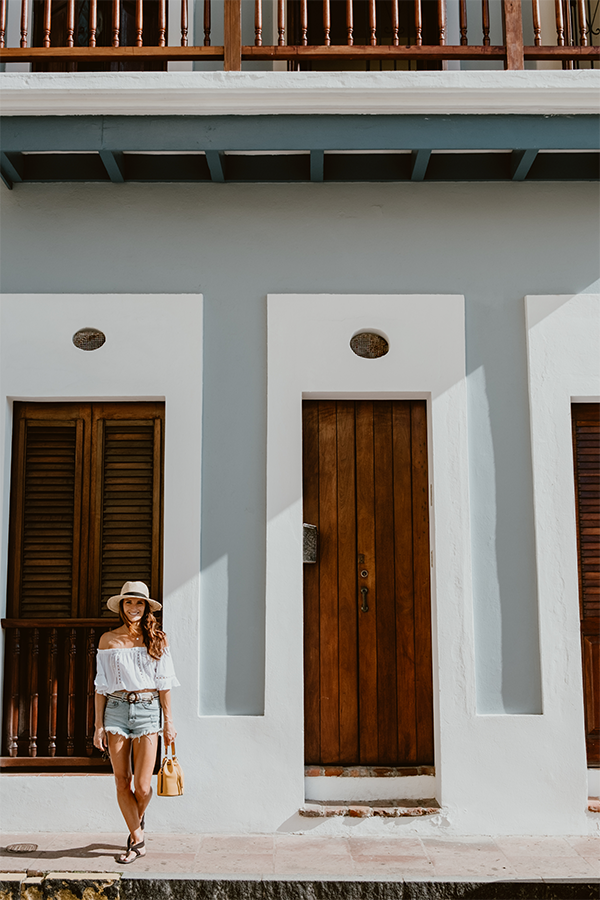


Old Town San Juan, Puerto Rico.
// In just a few hours the energy of the city shifts from a tranquil dawn to a scorching hot afternoon, then cools to a romantic dusk before heating back up into a boisterous, rum-fueled party that spills into the streets.
In fact, there’s so much to Old San Juan that it requires more than a single day to fully appreciate its endless vivacity and joyful, free-spirited atmosphere. While our self-guided walking tour gave us an initial look into the history of Old San Juan, we knew there was a lot more to learn about San Juan, the island of Puerto Rico and its incredible people.

// FOOD TRAILS
As with many cultures, food and drink is an incredibly important part of life in Puerto Rico. Local flavors can be used as a conduit to explain much of the complex history of the island and to give intimate insight into the everyday lives of Puerto Ricans.
We have always believed tasting and understanding local cuisine is crucial to understanding a culture and its people, so before leaving on our trip to Puerto Rico we booked a sunset walk and taste tour through Spoon Food Tours.
The three-hour outing started in late afternoon and took us once again through the cobblestone maze of Old San Juan using gastronomy, history and architecture as a passage to see the city and the Puerto Rican people from an entirely new perspective.
During the tour we stopped at many of San Juan’s key historical sites, but most importantly we had the opportunity to taste traditional and modern Puerto Rican fare from authentic, locally owned restaurants in the heart of Old Town.
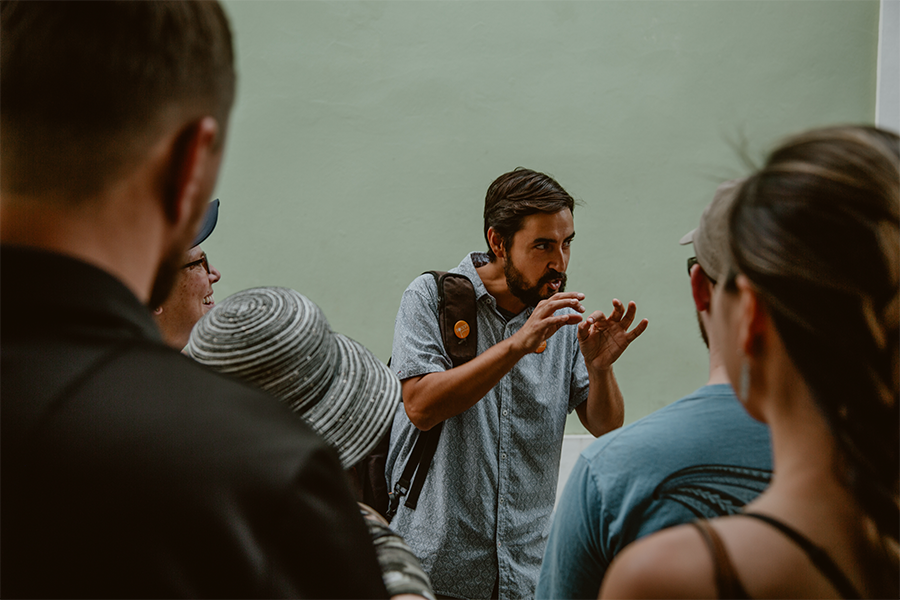
Pablo, our guide with Spoon Food Tours.
// Here are a few of our favorites in Old San Juan.
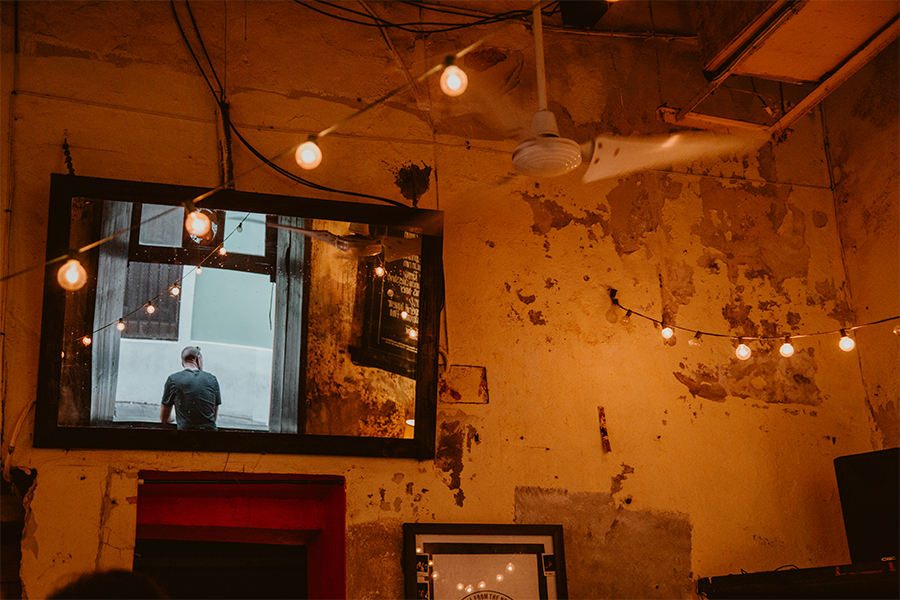
La Factoria
La Factoria is so famous it doesn’t even have a sign outside. Visitors need to look and listen for the lively bar scene and music pumping out the windows and doorways of the property on the corner of Calle San Sebastian and Calle San Jose. La Factoria has been named one of the world’s 50 best bars multiple times. It’s hands down the top mixology bar in Puerto Rico and boasts an enchanting and romantic atmosphere to go with it. There’s even a secret wine bar that can be accessed through a small wooden door in the back.

Deaverdura
Walking through the streets of Old San Juan travelers are surrounded by endless dining and drinking options, but for a truly authentic Puerto Rican meal, Deaverdura is the place to stop. This no thrills restaurant serves up simple, homemade Puerto Rican dishes offering a choice of chicken, shrimp, pork or fish with fried plantain, rice and beans or vegetables. There’s a good selection of local beers, cocktails and full bar, all with a friendly service.————————————————————
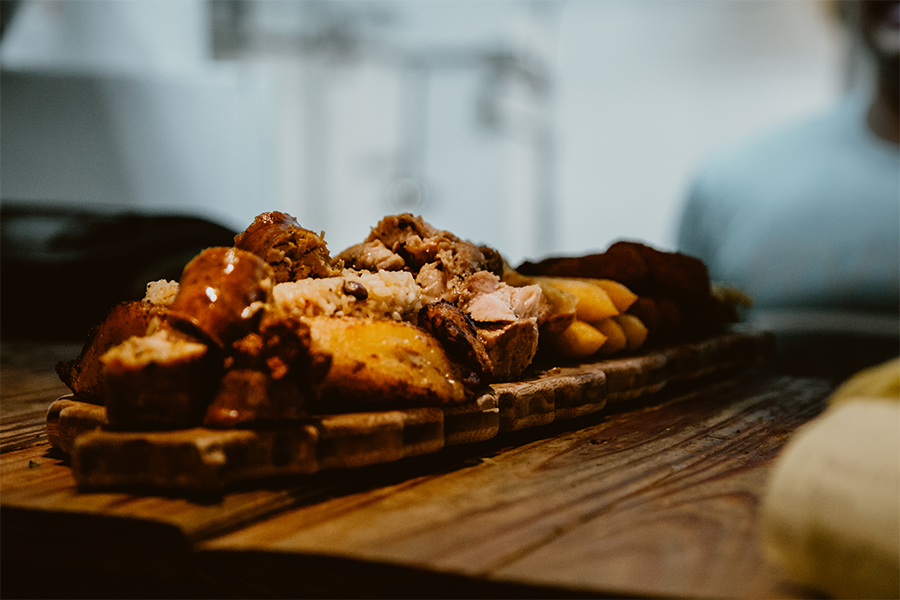
Alfresco
Located on the third floor above St. Germain and The Mezzanine, Alfresco is small rooftop wine and tapas bar in the heart of Old San Juan. The bar’s main attraction is its intimate terrace perched atop a beautiful colonial building offering views of the narrow cobblestone streets below. The restaurant was recently named the top rated wine and tapas bar in San Juan by TripAdvisor.—————————————-

Cuatro Sombras
Many locals consider Cuatro Sombras to be the best coffeehouse in Old San Juan. The coffee served here is grown in the mountains of Yauco in southwestern Puerto Rico, where the climate, elevation and terrain create the perfect environment to grow high-quality coffee beans. The coffeehouse opened in 2011 where the locally grown beans are roasted, ground, packed and served fresh every day.
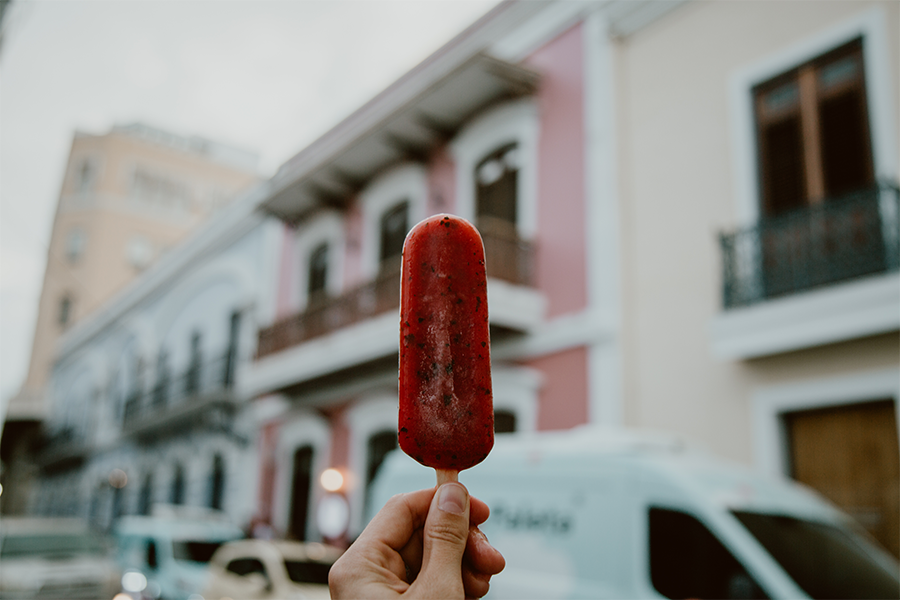
Senior Paleta
An extremely popular homemade gelato and sorbet popsicle shop serving a variety of natural flavors. The line is always long, but it moves quickly. Outside the shop the streets are filled with happy customers taking Instagram photos of their trendy popsicles in front of the surrounding pastel-colored buildings.————————————————————-
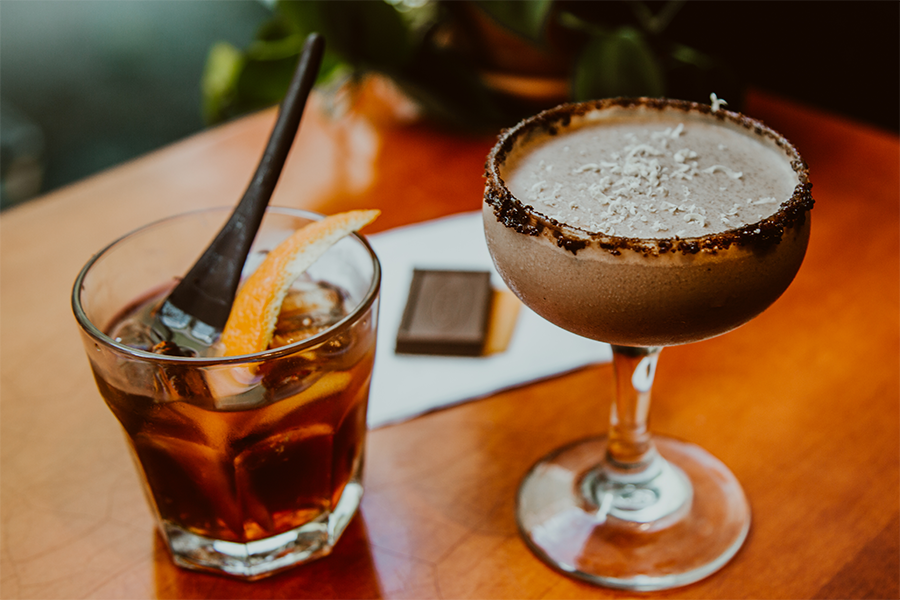
Chocobar Cortes
While coffee is a big part of Puerto Rican, so is chocolate. Chocobar Cortés is an innovative gastronomic space where chocolate plays the starring role. It celebrates the rich history of Chocolate Cortés, a family-owned company that has been making chocolate in the Caribbean since 1929. All of chocolate creations are made by hand, using fresh, locally sourced ingredients.
// The formal tour finished around 8 p.m. and the night was still young. Before leaving San Juan, we had to experience the famously wild and rowdy nightlife of Puerto Rico. Thankfully, our incredible guide, Pablo, pointed us in the right direction: La Placita de Santurce.
La Placita de Santurce was founded more than 100 years ago as a market square where people could buy fruit, vegetables and meat, but today the famous market is known as the hub of San Juan’s hottest nightlife. Especially packed on Thursday and Friday nights, the restaurants and bars surrounding the market fill to the brim and turn the plaza into one massive street party with eating, drinking and dancing until the early hours of the morning.




Santurce barrio in San Juan.
// While there are tons of bars and a number of speakeasies to find around La Placita de Santurce, these are two of the hotspots we enjoyed the most.
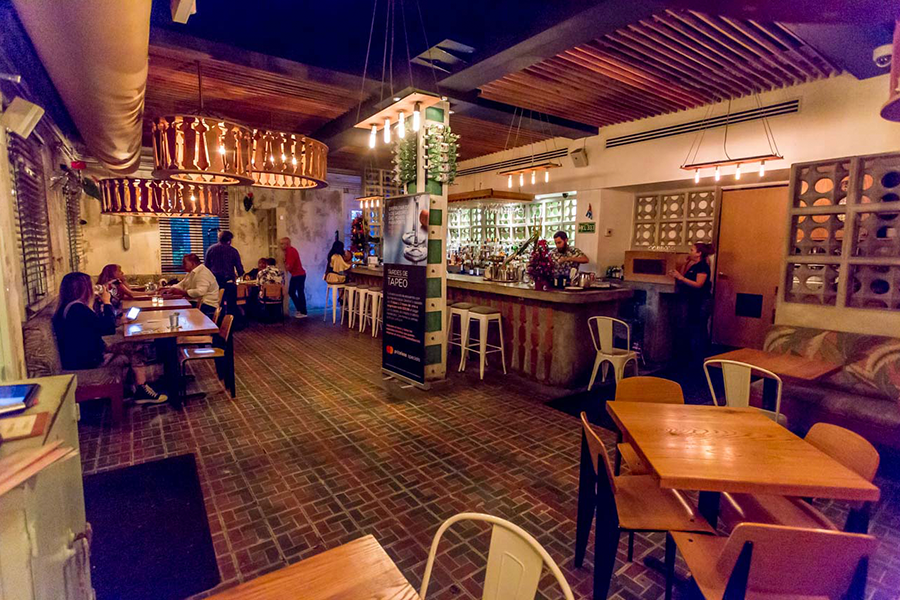
Asere Cubano Kitchen Bar
Asere is two story building in the center of La Placita de Santurce. The establishment emits a Cuban / Puerto Rican ambiance with a restaurant on the ground floor that honors Caribbean cuisine and a beautiful speakeasy bar on the second floor, with an exclusive terrace overlooking the “placita” and the crowded, partying streets.—————————————————————————————————-

Jungle Bird
Jungle Bird is a tropical leisure cocktail bar that sits amid the hustle and bustle of iconic La Placita de Santurce. Owned by the same company as the iconic La Factoria in Old San Juan, the cocktail bar serves Taino-tropical drinks paired with an incredible, always-changing food menu. Decorated with neon signs and an elaborate tiki theme, it’s the perfect oasis on the edge of La Placita de Santurce.
// These are just a few of the restaurants we had the privilege of trying, but the city of San Juan is packed with cafes, restaurants, bars and nightclubs – all that provide an intimate look into the culture and lives of Puerto Ricans.

// ISLAND ADVENTURE
Our time in San Juan offered the perfect dose of ancient history, rich culture and effervescent nightlight, but after three days in the city we were ready to get outside and see the natural beauty of the island.
From picture-perfect beaches and pristine reefs to epic hikes and the only tropical rainforest in the United States, Puerto Rico offers countless activities for the outdoor adventurer.
There are opportunities to surf, bike, hike, snorkel and dive in almost every corner of the island, but there are three must-do activities that every Puerto Rico itinerary should include.
El Yunque National Rainforest
El Yunque is the only tropical rainforest in the U.S. National Forest System. Located on the east side of Puerto Rico and at nearly 29,000 acres, it is one of the smallest of the U.S. national rainforests, yet one of the most biologically diverse. El Yunque is home to more than 240 types of trees, birds and native species, including the Coqui frog, which has become the unofficial mascot of Puerto Rico with its loud and distinctive call.
In addition to the exotic wildlife, the rainforest features 25 waterfalls and a variety of rivers and streams that can serve as perfect swimming holes on hot, humid days.
El Yunque is only a one-hour drive from San Juan, so visitors can explore the forest on their own or take a guided tour to see some of the most popular locations. We spent a day in El Yunque, hiking through the lush vegetation, swimming in the cold, refreshing rivers and admiring the panoramic views from Yokahu Tower, which sits at an elevation of 1,575 feet above sea level.
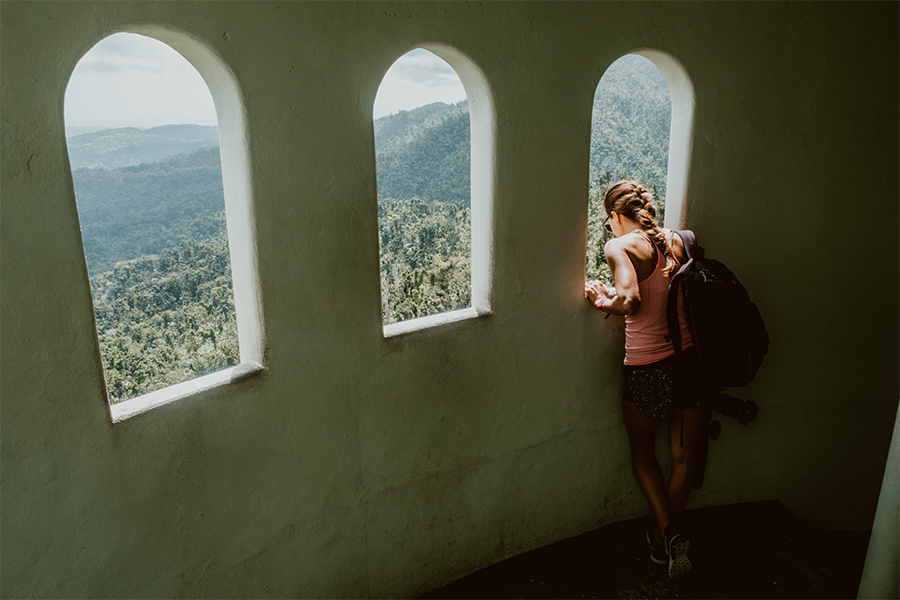
Yokahu Tower in El Yunque National Park.
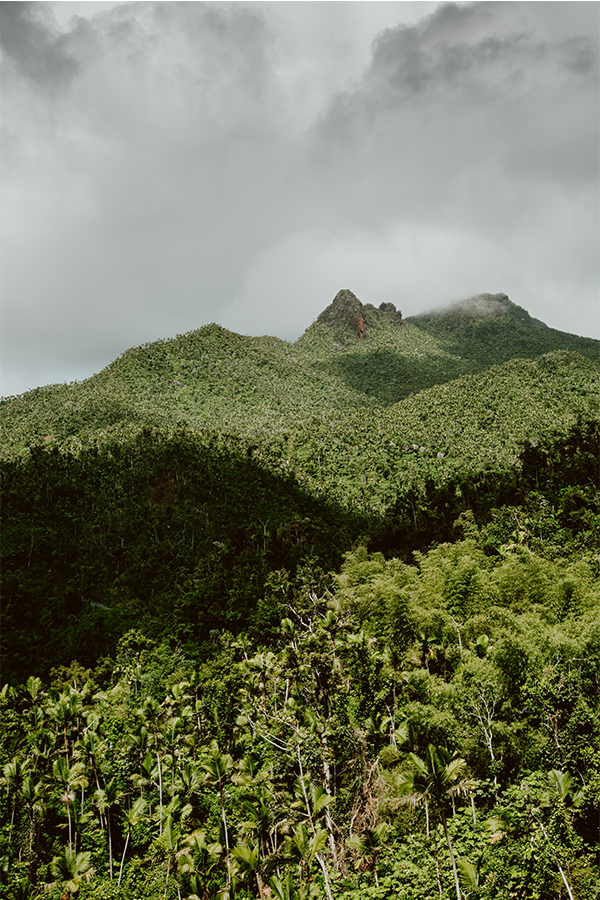


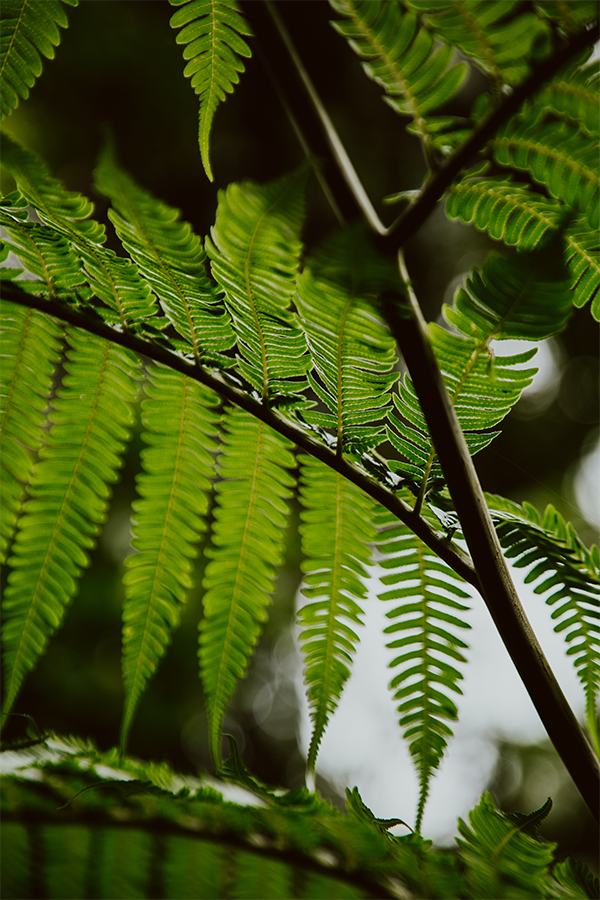
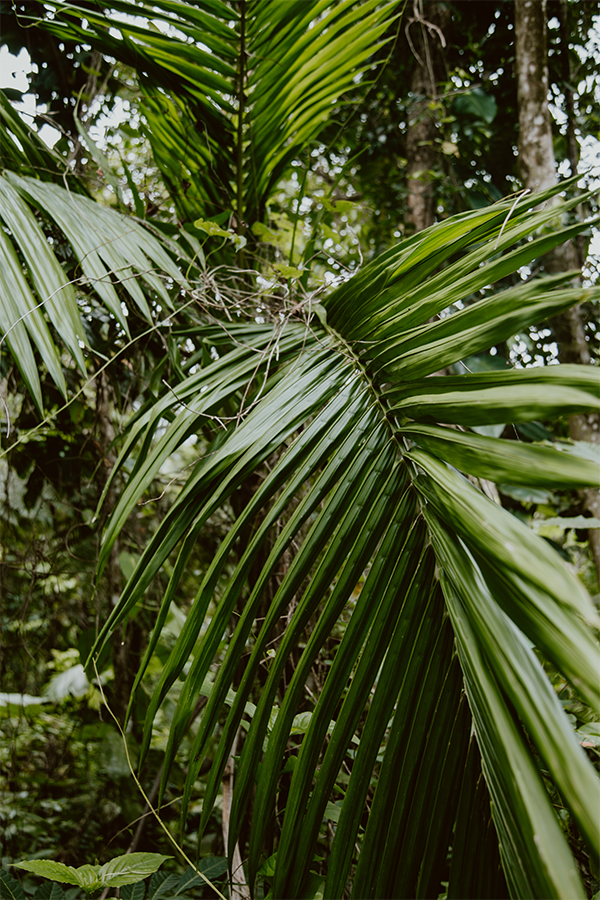
El Yunque National Park.

Flamenco Beach
Flamenco Beach is located on the small, sparsely populated island of Culebra, about 17 miles off the east coast of Puerto Rico. Flamenco has been named one of the most beautiful beaches in the world multiple times by various travel publications and is the perfect place to spend a day relaxing on the edge of the warm Caribbean Sea. We spent an afternoon at Flamenco, soaking up the sun, drinking Medalla Lights and swimming in the clear, shallow waters.
To get to the island of Culebra most visitors take the passenger ferry from Ceiba, a small town on the east coast of Puerto Rico. Tickets are $2.50 each way and the ferry ride takes about 45 minutes. Unfortunately, we made the mistake of buying only one-way tickets in advance, thinking that we would be able to purchase return tickets once we arrived on Culebra. When we arrived tickets back to Ceiba were sold out for the remainder of the day.
Despite a brief moment of panic and frustration, we didn’t let the situation ruin our day at the beach or our laidback island vibes. Rather than freaking out, we quickly moved to plan B and booked a one-way aero taxi flight from the airstrip on Culebra back to Ceiba. While it cost a lot more than the $2.50 ferry ride, getting to see the long crescent moon beaches of Culebra and the sparkling blue waters of the Caribbean Sea from the air was well worth the extra money.




Flamenco Beach, Culebra.
// Long story short, when buying ferry tickets to Culebra book the round trip in advance.
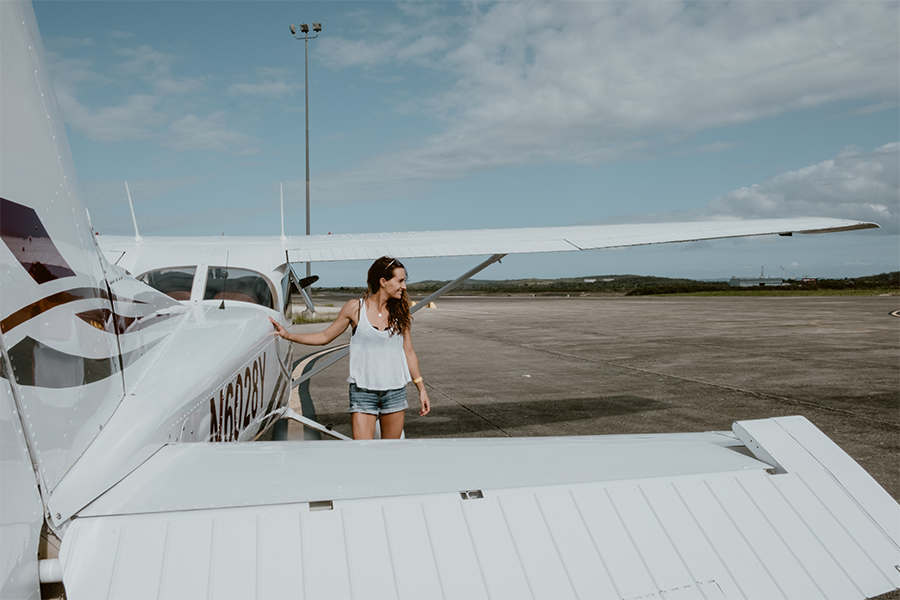
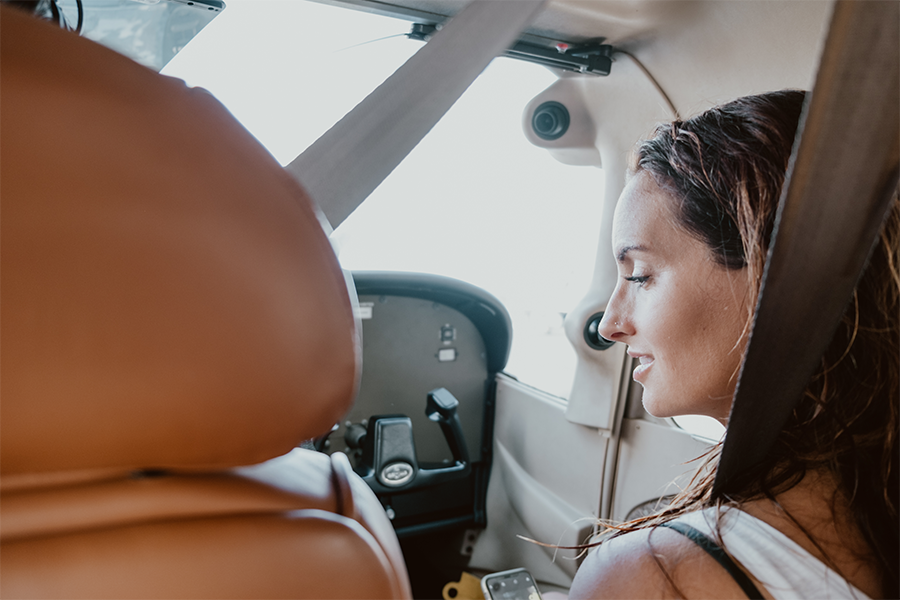
Flight back from Culebra to Ceiba.
Bioluminescent Bay
There are only five bioluminescent bays in the world and three of them are in Puerto Rico. When an ecosystem is this rare, it automatically becomes a must-see attraction. Bioluminescent bays are created when microscopic organisms called dinoflagellates grow in high enough concentrations to produce a “glow-in-the-dark” effect when they are stimulated by movement.
There are a few things to know about visiting a bioluminescent bay. The tours are usually done in kayaks, so wear comfortable clothing that you don’t mind getting wet. The less light, the easier it is to see the luminescence, so try to avoid full moon nights. Taking your camera is not necessary, because it won’t capture the glow as seen by the naked eye.
The three bioluminescent bays in Puerto Rico are Mosquito Bay in Vieques, Laguna Grande in Fajardo and La Parguera in Lajas. Mosquito Bay is the brightest and most famous but being on the small island of Vieques is more time consuming and slightly more difficult to reach.
Due to time constraints and simplicity, we visited Laguna Grande. It’s the bioluminescent bay closest to San Juan and easily accessible from the city by Uber or an arranged tour transfer. The experience was awesome and included a short kayak trip through a narrow mangrove canal that leads into the peaceful “glow-in-the-dark” lagoon.
Prices vary depending on the bay tour operator, but generally range from $50 to $75.

// HEART & SOUL
Yes, Puerto Rico is a beautiful island, but it’s an experience more than a destination. Around every corner, in every bar and restaurant and on every beach, you’ll find locals welcoming you to their home and immersing you in a vibrant culture full of dancing, food, friendship and love.
While the devastation of Hurricane Maria still lingers in the back of Puerto Rican’s minds and the damage is still visible in some areas, it’s safe to say Puerto Rico has recovered. In fact, the flooding and gale-force winds of Maria may have destroyed buildings and infrastructure across the island, but it never damped the resiliency of the Puerto Rican people.
// The thumping heart and soul of the Caribbean is alive and well. And its sun-kissed beaches, welcoming people and captivating rhythm are calling out to travelers around the world.
IF YOU GO
Most flights to Puerto Rico originate from the mainland USA and arrive into Luis Muñoz Marín International Airport in San Juan. Puerto Rico also has smaller airports: Mercedita Airport (PSE) on the southern coast and Rafael Hernández Airport (BQN) on the western coast. These airports are also frequently serviced from the U.S. mainland by a number of airlines including JetBlue.
The best way to get around the island really depends on your travel plans. In the city of San Juan, it’s best to get around using a combination of Uber and walking. NOTE: at the time of publication Uber drivers are not allowed to pick up at the San Juan airport, so a fixed-rate taxi is the best option for getting from the airport to where you are staying in San Juan.
If you’re planning to explore the island outside of the capital city, then renting a car is the best option. Rental cars can be picked up at the airport or at various locations throughout the island. Make sure to carry some spare change while driving, as the island is littered with toll roads.
WHERE TO STAY
There are many accommodation options in San Juan and throughout the island, ranging from hostels and Airbnbs to boutique and chain hotels.
In San Juan, we stayed at Casa Los Cummins, a chic, modern boutique hotel in the Condado neighborhood. Two blocks from the beach and a short distance from historic Old San Juan, the property is ideally located for taking in the beautiful sights and vibrant culture of Puerto Rico’s capital city.
One of the most impressive features of Casa Los Cummins is a roof top terrace, where guests can do early morning yoga, catch some mid-afternoon rays or drink a cocktail as the setting sun dances off the Condado skyline.
If part of your itinerary evolves staying outside of San Juan, it’s important to rent a car. Many of the hotels in rural and beach areas are isolated, making it difficult to call an Uber and expensive to use fixed-rate taxis every time you want to leave the property.